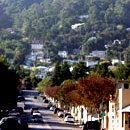In early May, the U.S. Department of Agriculture handed down a federal quarantine order to restrict the interstate movement of nursery stock, cut flowers, and other plants in hopes of curbing the spread of the light brown apple moth. The Australian native feeds on more than 250 plant species and could threaten California’s $38 billion agriculture industry. Included in the federal order are all of Alameda, Contra Costa, Marin, Monterey, San Francisco, San Mateo, Santa Clara, and Santa Cruz counties as well as the entire state of Hawaii. Just this past week, the California Department of Food and Agriculture (CDFA) added four areas of San Mateo County to its state quarantine. The four areas under quarantine range from 11 to 23 square miles and include portions of Colma, South San Francisco, Brisbane, Daly City, San Carlos, Belmont, San Mateo, Hillsborough, Woodside, Portola Valley, Menlo Park, Redwood City and Half Moon Bay.
The apple moth was first discovered in Berkeley on Feb. 6, its first detection in the continental United States. The moth eats fruit crops, oak trees, pine trees, and is particularly partial to crops like avocados, tomatoes, citrus and stone/drupe fruits such as peaches and plums (aggregate drupelet fruits include blackberries and raspberries). Recently, the moth has been trapped on Mill Street in Half Moon Bay and Coronet Boulevard in Belmont.
Staff has contacted the County Agricultural Commissioner’s office, who said even though there currently are no enforcements in place in regards to the general public, they're requesting for people to not take plant materials outside the quarantined area. It is, however, okay to put greenwaste in the recycling carts for collection by SSF Scavenger Co.
If you would like more information about the light brown apple moth and its impact on you, visit the CDFA’s website (under Hot Topics).
Subscribe to:
Post Comments (Atom)



No comments:
Post a Comment